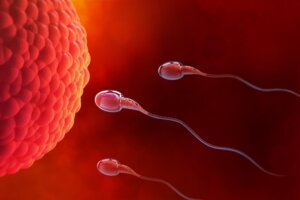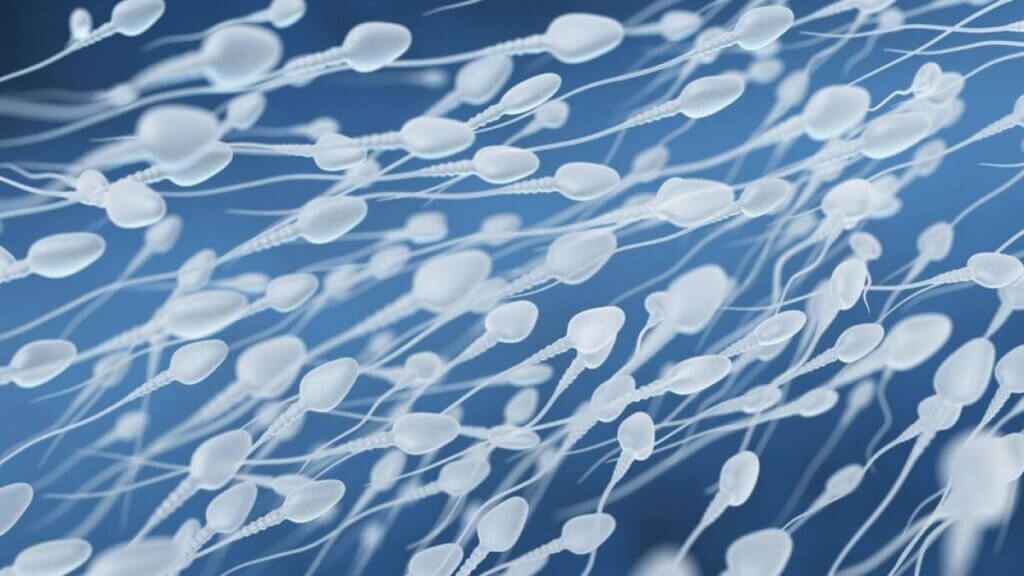7 Curiosities about Semen and Sperm

Although many don’t admit it, there are many things aspects of sex that remain taboo. There are many reasons for this, including a lack of knowledge. As in other aspects of life, ignorance can be very expensive, so keeping yourself informed is the best way to have a little more control over things. That’s why today we’re going to look at some curiosities about semen and sperm.
What you’ll find in the following lines aren’t intended to replace a sex education class. On the contrary, they’ll introduce you to things you didn’t know about semen and sperm in a fun and informative way. We’ll destroy some common myths and confirm other things that are only half-truths.
7 things you didn’t know about semen and sperm
When it comes to talking about semen and sperm, there’s a lot of general ignorance. For different reasons, asking or talking about it is still taboo, partly because it isn’t a topic that can come up in a conventional conversation.
1. Sperm and semen are not the same
We begin our article by pointing out a widespread misunderstanding: semen and sperm are not the same. Semen is the liquid that a man expels during ejaculation. It’s made up of 90% of what is known as seminal plasma. Among many other things, seminal plasma is made up of the following:
- Glycoproteins
- Oxytocin
- Antimicrobial peptides
- Antibodies
- Fibronectin
- Acid phosphatase
- Citric acid
- Inositol
- Calcium
- Zinc
- Magnesium
- Potassium
- Folic acid
- Enzymes.
- Cholesterol
The remaining 10% of semen is made up of sperm. This is made up of male reproductive cells. Semen is mainly made up of fluids and acids, while sperm is a cell that is made up of a head (acrosome, nucleus, and DNA), a neck (mitochondria), and a tail (flagellum).
2. Precum does contain sperm

Precum or pre-ejaculatory fluid is a substance produced in the Cowper’s glands and Littre’s glands. Its function is to lubricate, and it’s secreted as the man gets aroused. Most people believe that precum doesn’t contain sperm, and that’s why techniques such as coitus interruptus are still practiced to this day.
However, this fluid does contain sperm. A study published in Human Fertility in 2013 found that up to 41% of men have sperm in their precum, and in 37% of cases the quality and motility of these is sufficient to produce a pregnancy. It’s for this reason that the use of condoms is recommended from the beginning of sexual intercourse.
3. There are a lot of sperm in each ejaculation
On average, during ejaculation, between 1.5 and 5 milliliters are expelled. Each milliliter contains between 20 and 40 million sperm, despite the fact that these only make up 10% of the seminal fluid as we have seen.
The actual number varies in each case, since different day-to-day habits affect the number and quality. It isn’t uncommon for some men to expel 50, 60, or 80 million per milliliter.
4. Its consistency and flavor varies
Although the changes aren’t that pronounced, the truth is that diet and habits such as smoking affect the consistency and taste of the semen. The liquidity can vary, as can its sweetness or bitterness.
In the same way, the intake of liquids can also alter its taste and texture. If a man drinks a lot of water, its texture will be more liquid and its taste more neutral.
5. A man produces healthy sperm almost until his death
Contrary to what happens with women, who experience a period of permanent infertility after menopause, a man can continue to produce healthy sperm until his death.
It’s true that its quality and motility decreases after the age of 50, but if they have healthy life habits (playing sports, eating healthy, avoiding stress and controlling underlying diseases) then the quantity and quality expelled during ejaculation can perfectly fertilize a healthy egg.
6. Sperm can survive up to 5 days in the vagina
The vagina offers the perfect conditions for sperm to survive, so much so that they can remain in the vagina for up to 5 days, waiting for the right moment to fertilize the egg.
The same doesn’t happen when the sperm is in other conditions. Most of the time they only survive a couple of minutes outside the vagina. Colder or hotter surfaces hasten their death.
7. Some habits can reduce its motility and quality

As the evidence indicates, semen quality is conditioned by diet. A balanced diet is positively related to higher sperm quality, while the intake of highly sugary, fatty, and fried foods reduces sperm motility and overall quality.
But this isn’tt all, it is also known that smoking worsens the count and its quality, and studies suggest that markers of obesity do the same.
On the other hand, researchers warn that the type of underwear can increase or decrease the total production of semen. In general, men who wear boxer-style clothing report a higher sperm concentration per milliliter. There are many other factors and habits that affect its quality, but these are the most significant.
We hope that you’ve discovered new things about semen and sperm. Many of them will be useful for sexual health, both to enhance and prevent a pregnancy. If you have any questions about its quality and motility, don’t hesitate to consult a specialist to perform a sperm count test.
Although many don’t admit it, there are many things aspects of sex that remain taboo. There are many reasons for this, including a lack of knowledge. As in other aspects of life, ignorance can be very expensive, so keeping yourself informed is the best way to have a little more control over things. That’s why today we’re going to look at some curiosities about semen and sperm.
What you’ll find in the following lines aren’t intended to replace a sex education class. On the contrary, they’ll introduce you to things you didn’t know about semen and sperm in a fun and informative way. We’ll destroy some common myths and confirm other things that are only half-truths.
7 things you didn’t know about semen and sperm
When it comes to talking about semen and sperm, there’s a lot of general ignorance. For different reasons, asking or talking about it is still taboo, partly because it isn’t a topic that can come up in a conventional conversation.
1. Sperm and semen are not the same
We begin our article by pointing out a widespread misunderstanding: semen and sperm are not the same. Semen is the liquid that a man expels during ejaculation. It’s made up of 90% of what is known as seminal plasma. Among many other things, seminal plasma is made up of the following:
- Glycoproteins
- Oxytocin
- Antimicrobial peptides
- Antibodies
- Fibronectin
- Acid phosphatase
- Citric acid
- Inositol
- Calcium
- Zinc
- Magnesium
- Potassium
- Folic acid
- Enzymes.
- Cholesterol
The remaining 10% of semen is made up of sperm. This is made up of male reproductive cells. Semen is mainly made up of fluids and acids, while sperm is a cell that is made up of a head (acrosome, nucleus, and DNA), a neck (mitochondria), and a tail (flagellum).
2. Precum does contain sperm

Precum or pre-ejaculatory fluid is a substance produced in the Cowper’s glands and Littre’s glands. Its function is to lubricate, and it’s secreted as the man gets aroused. Most people believe that precum doesn’t contain sperm, and that’s why techniques such as coitus interruptus are still practiced to this day.
However, this fluid does contain sperm. A study published in Human Fertility in 2013 found that up to 41% of men have sperm in their precum, and in 37% of cases the quality and motility of these is sufficient to produce a pregnancy. It’s for this reason that the use of condoms is recommended from the beginning of sexual intercourse.
3. There are a lot of sperm in each ejaculation
On average, during ejaculation, between 1.5 and 5 milliliters are expelled. Each milliliter contains between 20 and 40 million sperm, despite the fact that these only make up 10% of the seminal fluid as we have seen.
The actual number varies in each case, since different day-to-day habits affect the number and quality. It isn’t uncommon for some men to expel 50, 60, or 80 million per milliliter.
4. Its consistency and flavor varies
Although the changes aren’t that pronounced, the truth is that diet and habits such as smoking affect the consistency and taste of the semen. The liquidity can vary, as can its sweetness or bitterness.
In the same way, the intake of liquids can also alter its taste and texture. If a man drinks a lot of water, its texture will be more liquid and its taste more neutral.
5. A man produces healthy sperm almost until his death
Contrary to what happens with women, who experience a period of permanent infertility after menopause, a man can continue to produce healthy sperm until his death.
It’s true that its quality and motility decreases after the age of 50, but if they have healthy life habits (playing sports, eating healthy, avoiding stress and controlling underlying diseases) then the quantity and quality expelled during ejaculation can perfectly fertilize a healthy egg.
6. Sperm can survive up to 5 days in the vagina
The vagina offers the perfect conditions for sperm to survive, so much so that they can remain in the vagina for up to 5 days, waiting for the right moment to fertilize the egg.
The same doesn’t happen when the sperm is in other conditions. Most of the time they only survive a couple of minutes outside the vagina. Colder or hotter surfaces hasten their death.
7. Some habits can reduce its motility and quality

As the evidence indicates, semen quality is conditioned by diet. A balanced diet is positively related to higher sperm quality, while the intake of highly sugary, fatty, and fried foods reduces sperm motility and overall quality.
But this isn’tt all, it is also known that smoking worsens the count and its quality, and studies suggest that markers of obesity do the same.
On the other hand, researchers warn that the type of underwear can increase or decrease the total production of semen. In general, men who wear boxer-style clothing report a higher sperm concentration per milliliter. There are many other factors and habits that affect its quality, but these are the most significant.
We hope that you’ve discovered new things about semen and sperm. Many of them will be useful for sexual health, both to enhance and prevent a pregnancy. If you have any questions about its quality and motility, don’t hesitate to consult a specialist to perform a sperm count test.
- Killick SR, Leary C, Trussell J, Guthrie KA. Sperm content of pre-ejaculatory fluid. Hum Fertil (Camb). 2011;14(1):48-52.
- Ma, J. X., Wang, B., Li, H. S., Jiang, X. J., Yu, J., Ding, C. F., & Chen, W. Q. Association between obesity-associated markers and semen quality parameters and serum reproductive hormones in Chinese infertile men. Reproductive Biology and Endocrinology. 2020; 18(1): 1-15.
- Mínguez-Alarcón L, Gaskins AJ, Chiu YH, et al. Type of underwear worn and markers of testicular function among men attending a fertility center. Hum Reprod. 2018;33(9):1749-1756.
- Mendiola J, Torres-Cantero AM, Moreno-Grau JM, Ten J, Roca M, Moreno-Grau S, Bernabeu R. Food intake and its relationship with semen quality: a case-control study. Fertil Steril. 2009 Mar;91(3):812-8.
- Sharma R, Harlev A, Agarwal A, Esteves SC. Cigarette Smoking and Semen Quality: A New Meta-analysis Examining the Effect of the 2010 World Health Organization Laboratory Methods for the Examination of Human Semen. Eur Urol. 2016 Oct;70(4):635-645.
Este texto se ofrece únicamente con propósitos informativos y no reemplaza la consulta con un profesional. Ante dudas, consulta a tu especialista.







